Pollen Microgels
Next Generation Possibilities
Microgel Synthesis
Microgels are defined as swollen colloidal particles with diameters ranging from tens of nanometers to several micrometers in size.
We have developed a novel alkaline hydrolysis process that gives rise to pollen grains that were very much softer than its naïve counterparts. This process effectively converts the pollen grains into discrete, pliable microgels. The resultant pollen suspension transitions from a wet sand consistency to an increasingly translucent gel-like slurry with increased hydrolytic processing time.
-
Fan, Park, Shi, Zhang, Liu, Song, Chin, Ibrahim, Mokrzecka & Yang. Transformation of hard pollen into soft matter. Nature communications 11, 1449 (2020).
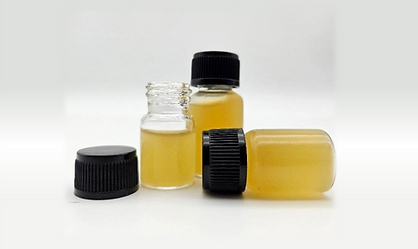
Similar to soapmaking, we have designed a sustainable and translatable approach to transform inert pollen into incredible building blocks.
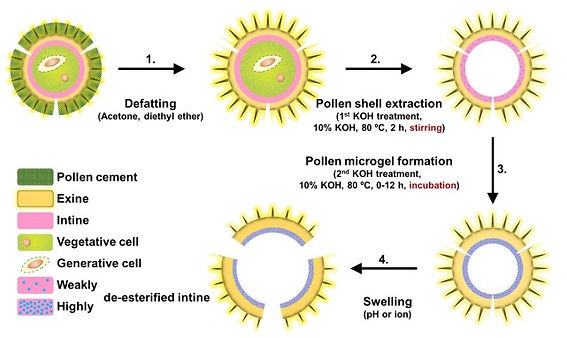
Defatting: Treatment with organic solvent to remove excess lipid coating
Shell extraction: Pollen incubation in alkaline conditions for 2 h at 80 °C under stirring condition
Microgel formation: Extended incubation in alkaline conditions at 80 °C for up to 12 h
Gelation: Swelling of pollen microgels induced by water rinsing
Properties : Stimuli-responsive swelling
By modulating the environmental pH or cation concentrations, the pollen microgels can instantaneously respond by spontaneously swelling or shrinking,
pH Responsive swelling
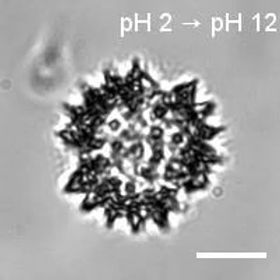
Divalent cation responsive swelling
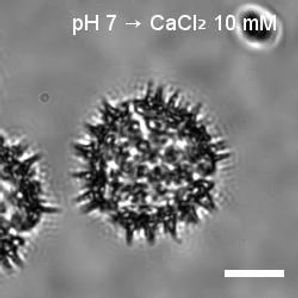
Trivalent cation responsive swelling
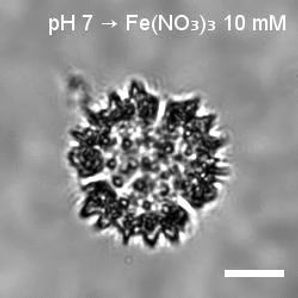
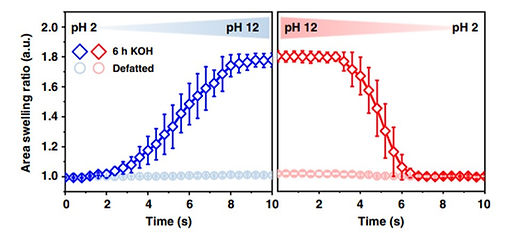
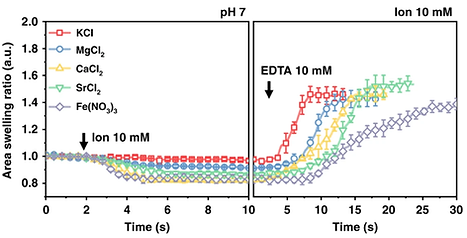
Properties : Soft Particles
Although renowned for its robustness, our modular synthesis methodology successfully softens the tough pollen shell, transforming hard pollen particles into pliable building blocks.

Increasing duration of incubation stage leads to corresponding decrease in modulus of the pollen shell
Young’s modulus values of exine and intine layers of various pollen microgels as a function of KOH incubation time.
Ratio of the Young’s modulus values of the exine and intine layers ( decreased from 2.7 to 1.2 after a 24h synthesis.
-
Fan & Park et al. 2020
Applications of pollen microgels

Pollen has unique geometrical structure with uniform size depending on plant species. Sporopollenin, that is a main component of outer layer of pollen, provides high chemical and mechanical strength. Based on literature, sporopollenin could have aliphatic-polyketide-derived polyvinyl alcohol units and 7-O-p-coumaroylated C16 aliphatic units, although the exact chemical and molecular structures are not fully understood yet. Pollen grains are known to be practically indestructible along with demonstrating excellent biocompatibility, and functionalized pollen particles have been used for environmental and biomedical applications(1-3).
Controlled alkali-treatment transforms pollen into soft microgel particles that can be applied to various conventional material processes. Individual pollen microgel particles can be used as smart drug carriers which are responsive to pH or ion strength changes. Due to the specific microtopography and abundant active functional groups (hydroxy or carboxy) of the alkali-treated pollen materials, sophisticated functions could be achieved by chemical modifications or incorporating other functional micro/nano-materials.
More importantly, soft pollen microgel particles can be processed for fabrication of thin films or sponges. As the pollen microgels are responsive to external stimuli including pH and ionic strength,
Fundamental research on pollen microgel systems into various applications is rapidly expanding.
these systems can be utilized as biosensors, chelating agents for purification or smart tissue scaffolds with tunable porous structures. In addition, pollen microgel particles display uniformity, thermal and mechanical stability, and stimuli-responsive nature with strong material interfaces that confers its many advantages over natural polymer-based microgels. Natural polymer-based microgels are not thermally stable and have irregular particle shapes and a heterogeneous size distribution (4 -6), which hampers their utility for freeform 3D printing (7). As such, pollen microgels can be an excellent source of natural materials for 3D/4D printing.
-
Wang, H.; Potroz, M. G.; Jackman, J. A.; Khezri, B.; Marić, T.; Cho, N.; Pumera, M. Bioinspired Spiky Micromotors Based on Sporopollenin Exine Capsules. Adv. Funct. Mater. 2017, 27 (32), 1702338.
-
Maric, T.; Nasir, M. Z. M.; Rosli, N. F.; Budanović, M.; Webster, R. D.; Cho, N.; Pumera, M. Microrobots Derived from Variety Plant Pollen Grains for Efficient Environmental Clean up and as an Anti‐cancer Drug Carrier. Adv. Funct. Mater. 2020, 30 (19), 2000112.
-
Tan, E.; Potroz, M. G.; Ferracci, G.; Jackman, J. A.; Jung, H.; Wang, L.; Cho, N. Light‐induced Surface Modification of Natural Plant Microparticles: Toward Colloidal Science and Cellular Adhesion Applications. Adv. Funct. Mater. 2018, 28 (18), 1707568.
-
Bhattacharjee, T.; Zehnder, S. M.; Rowe, K. G.; Jain, S.; Nixon, R. M.; Sawyer, W. G.; Angelini, T. E. Writing in the Granular Gel Medium. Sci. Adv. 2015, 1 (8), e1500655.
-
Hinton, T. J.; Jallerat, Q.; Palchesko, R. N.; Park, J. H.; Grodzicki, M. S.; Shue, H.-J.; Ramadan, M. H.; Hudson, A. R.; Feinberg, A. W. Three-Dimensional Printing of Complex Biological Structures by Freeform Reversible Embedding of Suspended Hydrogels. Sci. Adv. 2015, 1 (9), e1500758.
-
Hinton, T. J.; Hudson, A.; Pusch, K.; Lee, A.; Feinberg, A. W. 3D Printing PDMS Elastomer in a Hydrophilic Support Bath via Freeform Reversible Embedding. ACS Biomater. Sci. Eng. 2016, 2 (10), 1781–1786.
-
Chen, S.; Shi, Q.; Jang, T.; Ibrahim, M. S. B.; Deng, J.; Ferracci, G.; Tan, W. S.; Cho, N.-J.; Song, J. Engineering Natural Pollen Grains as Multifunctional 3D Printing Materials. Adv. Funct. Mater. 2021, 31 (49), 2106276. https://doi.org/10.1002/adfm.202106276.
Can these microgels be made from any pollen ?
Many pollen species have exhibited ability to form microgel via this alkali hydrolysis microgel synthesis procedure. KOH-treated, tested pollen species from eudicot plants such as Sunflower, Baccharis, Camellia, Sumac, Motherwort, Lotus and Poppy formed gels and were highly responsive to pH changes (1).
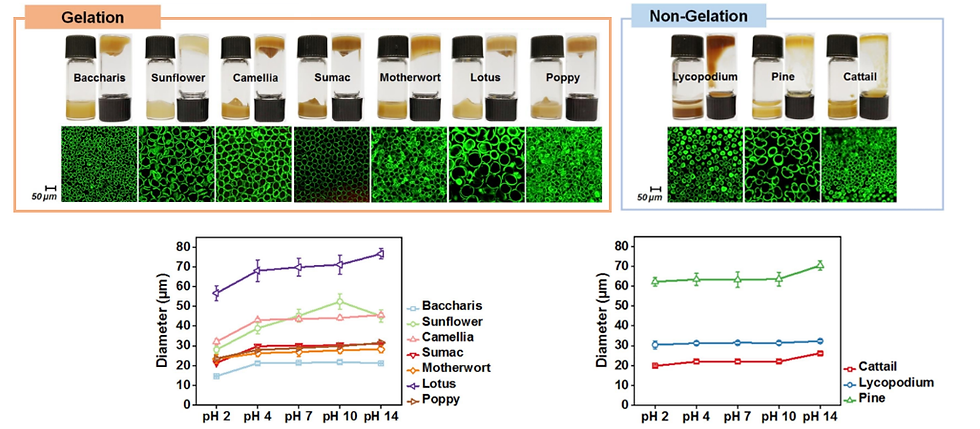
-
Fan, T.-F.; Park, S.; Shi, Q.; Zhang, X.; Liu, Q.; Song, Y.; Chin, H.; Ibrahim, M. S. B.; Mokrzecka, N.; Yang, Y. Transformation of Hard Pollen into Soft Matter. Nat. Commun. 2020, 11 (1), 1449.

